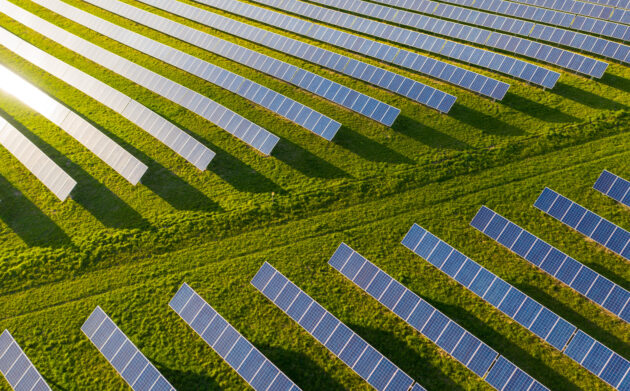
Mixed-use solar and agricultural land is the silver bullet Alberta’s Conservatives have wished for
by Joshua M. Pearce John M. Thompson, Chair in Information Technology and Innovation and Professor, Western University

There is a real concern among some in the party and the general public that industrial solar will displace farming and raise food prices as well as create end-of-life problems with potentially abandoned equipment.

Solar Energy Panels. Adobe stock
By engel.ac.
The Alberta government recently announced a much-maligned seven-month pause on renewable (including solar) energy development in the province. While the exact reasons are up for debate, one specific factor has been the desire to investigate ways to make renewable energy, particularly solar, more integrated within the province over the long term.
Specifically, there is a real concern among some in the party and the general public that industrial solar will displace farming and raise food prices as well as create end-of-life problems with potentially abandoned equipment.
Luckily, we can have our cake and eat it too, with a new concept of agrivoltaics. Agrivoltaics is the simultaneous placement of food crops and solar photovoltaic systems that produce electricity directly from sunlight — while also producing a beneficial micro climate. Covering crops with solar panels may not seem intuitive, however, dozens of studies from all over the world have shown that many crop yields increase when they are partially shaded from solar panels.
This is good news for everyone, but especially for Alberta’s ruling Conservatives, as it provides a seemingly simple solution to a potentially complicated land-use debate between agriculture and energy generation within the province.
Alberta and energy
Alberta’s energy portfolio is changing rapidly. Low-cost solar energy is now growing so fast as to be a “gold rush” in Alberta.
In fact, much to Ontario’s shame, Alberta has taken on the leadership role in solar development in Canada, generating millions of solar dollars and creating thousands of solar jobs for Alberta’s energy workers.
Solar companies have grown so fast precisely because there is profit in offsetting costly fossil-fuel electricity. However, many in Alberta are worried that this new boom will lead to higher food costs, scarred landscapes and a repeat of costs from cleaning up after the oil and gas industry.
This particular land-use conflict between solar and agriculturehas been a concern for solar researchers like myself for some time. However, our research in the United States has shown that agrivoltaics provide higher economic productivity, energy and food yields. So much so that the U.S. Department of Energy is now investing millions of dollars to ensure America’s dominance in the field.
One of the studies in the U.S., for example, observed pepper production shoot up by more than 200 per cent while other crops like wheat in Germany were more reserved with a few per cent increase — but they still produced more wheat.
Not surprisingly, agrivoltaics is slated to grow to a $9.3 billion market by 2031.
Agrivoltaics in Canada
Agrivoltaics is happening right here in Canada already (mostly with sheep grazing between panels on marginal land). Last year, we held the first agrivoltaics conference anywhere in North America at the Ivey Business School.
The trade group made up of farmers and solar companies called Agrivoltaics Canada has formed because agrivoltaic farming can help meet Canada’s food and energy needs all the while getting rid of our fossil fuel reliance and greenhouse gas emissions (and the associated emissions liabilities).
Agrivoltaics will allow Alberta’s farmers to keep farming, make more money, drop energy costs, and help protect the environment for all of our children. To take advantage of all the profit that agrivoltaics represents for the province, our team completed a study that showed the changes to Alberta’s regulations would actually need to be relatively modest.
The simple trick is to install solar systems that enable conventional farming, so farmers do not need to change anything. By spacing solar rows out far enough that combines/tractors can drive between them using vertical racks or tracker systems, agrivoltaics are out of the way when the farmer needs to farm. We did a study that looked specifically at Alberta’s agrivoltaic potential, which was second only to Saskatchewan in Canada.
Moving forward together
Agrivoltaics really has broad appeal. Farmers love it as it increases yields and provides steady incomes and so do solar developers and environmentalists. Even most Americans support solar development when agrivoltaics protects farm jobs. It is thus not surprising that agrivoltaics is exploding on the world market.
Eighty-nine per cent of Alberta’s electricity came from fossil fuels, yet we published an article this year that showed that agrivoltaics on just one per cent of the current agricultural land would eliminate the carbon emissions entirely. Less than one per cent of Alberta’s farm land dedicated to agrivoltaics, cuts all harmful emissions from Alberta’s electricity sector while making more food.
This is a win-win for the farmers, and consumers alike. As Alberta’s Conservatives are now able to lift the renewable energy ban knowing that the environment and the food system will be protected, they should ensure that large-scale solar in the province is encouraged to be agrivoltaic. Then all of us, regardless of party, can enjoy the conserved beauty of nature, lower-cost electricity and more food produced per acre. Whether or not this will result in lower costs at the grocery store checkout is a question yet to be answered — but we can hope.
This article is republished from The Conversation under a Creative Commons license. Read the original article.